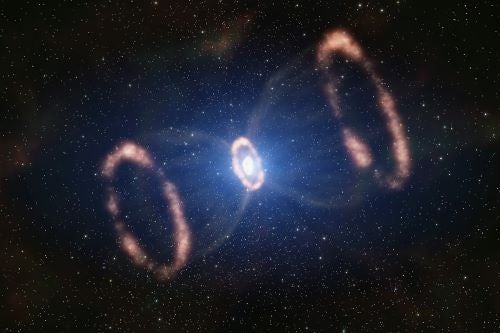Q: Why does Supernova 1987A look like a ring instead of a spherical ball of debris?
A: Supernova 1987A is a supernova remnant in the Large Magellanic Cloud, the Milky Way’s largest satellite galaxy. The remnant was created when a massive star exploded — an event we saw here on Earth in February 1987. Since then, the remnant has evolved as the energy from the exploding star travels outward, slamming into nearby gas and dust.
But if the explosion sent material and energy in all directions, then why does the remnant appear to have three rings, instead of looking like a sphere? The answer lies in what happened before the supernova, in the behavior of the progenitor star doomed to explode. As that star neared the end of its life, it evolved from a red supergiant star into a blue supergiant star. At the same time, the star’s winds changed from dense and slow-moving to thin and fast-moving. When the fast-moving wind collided with the slower-moving wind that was ejected before it, it caused material to pile up around the star. Furthermore, astronomers believe that, based on factors such as the star’s magnetic field and its rotation during the red supergiant phase, more material piled up around its equator and in regions around its poles. When faster winds crashed into those regions later, it formed three distinct rings.
When the star finally exploded, the energy from the blast moved outward in all directions. The rings we now see are caused by shocks that occur as that energy smacks into the existing rings, exciting the gas and lighting them up. The other areas around the now-dead star aren’t glowing in a sphere simply because there isn’t much material there, since it’s mostly concentrated in the rings that were left behind from before the explosion. Over time, these rings have appeared to change and expand as the shocks move through them, illuminating new regions as the material closer to the star fades once the shock has passed.
To complicate matters, astronomers suspect the supernova explosion itself was possibly not symmetric, but instead sent more energy in one direction than others, exaggerating the nonspherical shape of the remnant we see.










